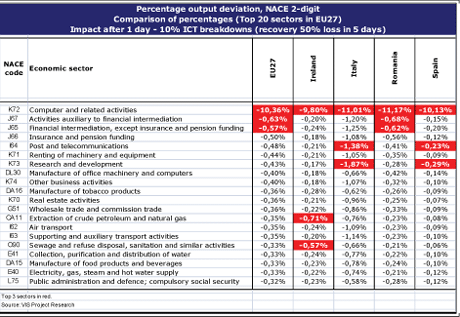by Fabio Bisogni, Simona Cavallini and Cristiano Proietti
What would happen to your economy in the case of ICT breakdowns? Can the economic impacts of ICT shortages be assessed? Are the effects of ICT breakdowns the same in all European countries? The VIS research project attempts to answer these questions by investigating the vulnerability of European industrial systems.
IFn 2007, the Italian FORMIT Foundation was awarded a grant for the research project ‘The Vulnerability of Information Systems and inter-sectorial economic and social impacts – VIS’ within the framework of the programme ‘Prevention Preparedness and Consequence Management of Terrorism and other related Risks’ of the European Council. This project analyses the economies of all the 27 member states and provides results at national and European level.
VIS collects information on the vulnerability of economic sectors, which is provided to policy makers responsible for guaranteeing prevention and/or ensuring preparedness for potentially dangerous events. In this framework, VIS deals specifically with the potential damage that can be caused by an unexpected ICT shortage.
The VIS project has developed a model and an econometric computer-based tool (VIS-S) for this purpose. The model identifies the condition of equilibrium by measuring the weight (or contribution) of ICT in the production activity of the industrial sectors in a given economy in absence of shocks. Technically, the VIS model is a computational general equilibrium model where a supply side (production activities of enterprises in a given economic sector) and a demand side (final consumption activities of individuals and intermediate consumption of enterprises of the given economic sector) define the condition of equilibrium. A VIS-S simulation breaks this equilibrium by introducing into the model a shock caused by an ICT shortage and calculates the consequences at sector level, taking into account interdependencies and cascading effects. In particular, the tool can simulate different intensities of shortage, different breakdown lengths of time and different recovery times, thus computing the sectorial effects on five specific variables:
- labour deviation (expresses the in-crease or diminution of employment)
- output loss (calculates quantity of production loss)
- production value loss (calculates the monetary value of the production loss)
- price deviation (captures the variation in prices necessary to restore the condition of equilibrium)
- welfare loss (synthesizes the damages according to a more social perspective).
- The output of the simulation is a ranking of the sectors most likely to be affected by an unexpected ICT breakdown.
Table 1 gives an example of a simulation that can be generated by VIS-S. Output loss variations are compared in the EU27 area and for four member countries, showing the effects on the top 20 sectors of a hypothetical 10% ICT breakdown (sectors are ranked following the NACE classification provided by EURISTAT. This classification breaks down European economies into specific economic sectors. The digit (1,2,3 and 4) indicates the partition level of the country economy. In this case, the research refers to the NACE 2-digit classification). The simulation considers the effect after one day and a five days recovery time in order to re-establish a 50% of the production loss capacity ( to better clarify,if the system affected by the ICT shortage loses the amount X of its production capability, the simulation considers 5 days as the time necessary to recover the half of X. The first column provides a ranking of the 20 most affected sectors in Europe, while the other columns show the same sectors for a sample of four European countries. The top three ICT vulnerable sectors per country are highlighted in red.

Table 1: Output loss deviation in the top 20 sectors In EU27, Ireland, Italy, Romania and Spain.
The output loss variable is of great interest because it provides information about the reaction of selected economies to the ICT shock in terms of production quantity loss. As shown in the table, there is a close similarity between the Italian and Spanish results, especially concerning the top positions. However, the values differ, with the Italian values being significantly higher than the Spanish ones. This implies a major maturity of the Italian economy in terms of ICT use and pervasiveness. Another interesting element highlighted by the table is the similarity of the Romanian system with the data for EU27 in terms of sector ranking. In contrast, the role of ICT in the Irish economy has weights and modalities completely different from the others areas investigated.
The simulation of the effects on output loss is just one of the examples of the VIS-S functionality. The potentially many scenarios (in terms of percent of ICT damages) and the possible different perspectives (obtained, for instance, by analysing the effects through the different variables) can provide strategic information to support policy makers and stakeholders (such as IT managers, business continuity managers, organizations for citizen security etc) in the analysis of decisions and design of interventions to reduce the socio-economic impacts of ICT breakdowns.
Stakeholders such as national civil defence agencies, those involved in prevention and consequence management of security risks, national and international associations for the protection of critical infrastructures, national and international organizations for business impact analysis, and national and European policy makers, can test VIS-S via customized simulations on the dedicated session of the project Web site.
Links:
http://www.formit.it/vis
http://ec.europa.eu/justice_home/funding/cips/funding_cips_en.htm
http://ec.europa.eu/eurostat/
Please contact:
Fabio Bisogni, Simona Cavallini and Cristiano Proietti
FORMIT, Italy
Tel: +39 065165001
E-mail:










